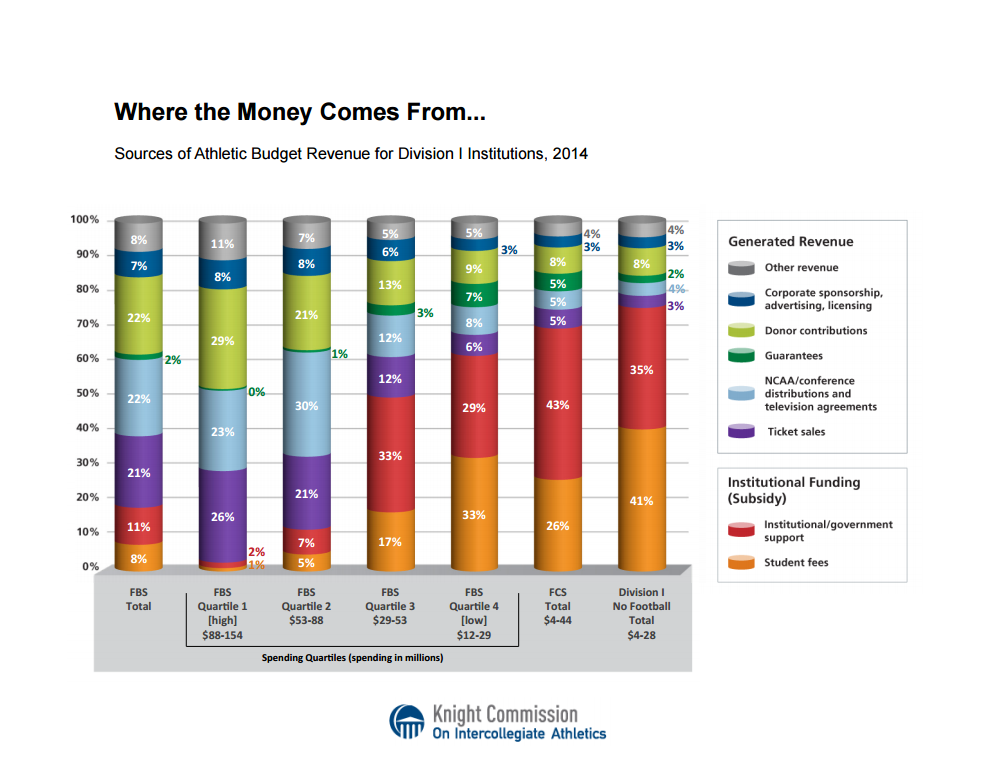You have /5 articles left.
Sign up for a free account or log in.

Knight Commission
WASHINGTON -- In December, William E. Kirwan will retire from the Knight Commission on Intercollegiate Athletics after serving a decade as the group’s chair. Following his final meeting on Monday, Kirwan shared a grim prediction for the future of the Football Bowl Subdivision, the most competitive level of the National Collegiate Athletic Association.
The “out of control expenditures” seen among the division’s top programs, Kirwan said, are creating a financial divide that will eventually force out all but the wealthiest institutions. If the prediction holds, the University of Idaho’s decision to leave the FBS in April would be only the beginning of an eventual exodus.
“The discrepancy between the haves and have-nots is just growing so significantly, and I think we will definitely see more University of Idahos in the future,” Kirwan said. “I think as this have and have-not gap gets wider and wider, more and more schools are going to drop out of the FBS and that’s when a crisis is going to start to emerge, because the model of FBS is dependent on 120 schools playing and we’re reaching a point where that’s just not going to be possible.”
The instability and heavy spending of the Football Bowl Subdivision was a common theme during the commission’s meeting here Monday.
Some at the meeting, including Kirwan, said they would support an antitrust exemption for the NCAA that would allow the association to cap coaching salaries and other athletic spending. Sandy Barbour, athletics director at Pennsylvania State University, said college sports' current level of spending was "unsustainable." Scott Cowen, the former president of Tulane University, also called the current model “not sustainable" and blamed the Power Five leagues -- the 65 wealthiest programs, which gained the ability to create their own rules in 2014 -- for driving the increase in spending.
In 2005, revenue generated by the Power Five leagues was $570 million. According to the Knight Commission, that revenue will be $2.8 billion by 2020.
During the meeting, the commission released a report that examined the various sources from which Division I institutions receive their revenue and how the money is spent. For the FBS, about 8 percent of athletic budget revenue comes from student fees, with another 11 percent coming from institutional and government support. At the Football Championship Subdivision level, student fees account for 26 percent of revenues and 43 percent of the budget is provided through institutional and government support.
For colleges that have no football program, the athletic department is mostly subsidized, with 41 percent of the funds coming from student fees and 35 percent from institutional support.
Bernadette McGlade, commissioner of the basketball-centric Atlantic 10 conference, said the Knight Commission's report demonstrates why the NCAA men's basketball tournament is so important to colleges that do not have an FBS football team. Unlike FBS programs, these institutions do not see any revenue from the college football playoffs. "There's no argument that relying on a single source of revenue for any business, enterprise or association with an operating budget and organizational programming as large as the NCAA is, quite frankly, living dangerously," McGlade said.
During Monday’s meeting, Jeff Bourne, athletics director at James Madison University, said $34 million of the university’s $47 million sports budget is funded by student fees. Bourne said the university is currently examining whether it should join the FBS. In recent years, other institutions that heavily subsidize their athletic budgets with student fees and institutional support have discussed making the opposite move: from the FBS to the FCS, or eliminating football completely.
- In 2014, the University of Alabama at Birmingham became the first institution in nearly 20 years to shut down its big-time Division I football program. Citing rising costs and the growing stratification of college sports, Ray Watts, the university’s president, said killing the program would help save Birmingham $50 million over the next decade.
- Last year, some faculty and students at the University of Akron urged the university to decrease football spending by dropping to the FCS. A $60 million deficit had prompted the university to announce staff layoffs and the elimination of its baseball team. Meanwhile, the university was spending $8 million per year to subsidize a football team with the lowest attendance in the Football Bowl Subdivision.
- Earlier this year, the Faculty Senate and student government at Eastern Michigan University told university administrators that its heavily subsidized FBS football team should leave for the FCS.
In the end, none of these programs dropped football or moved down to the FCS, however. Alabama Birmingham’s decision created an intense backlash on campus, setting off a tumultuous six months that eventually resulted in a complete reversal of the decision. Akron’s president said that moving to the FCS was “not on the table.” When faculty members and students made their suggestion at Eastern Michigan, the university stated that it had “absolutely no plans to eliminate football or move into any other division or conference.”
Chuck Staben, president of the University of Idaho, said in an interview Monday that if the sort of change Kirwan predicts is coming, he hasn’t seen many signs that it will be soon. Since announcing Idaho’s move to the FCS in April, other institutions “have not been knocking” on the president’s door, he said.
Idaho’s decision was made easier by the Sun Belt Conference choosing not to renew the university’s membership earlier this year. For other institutions with struggling football programs, Staben said, having a place in a conference may mean it’s not worth making the transition. Even for Idaho, the move hasn’t been without complications. When the decision was announced in April, several donors expressed anger and said they would no longer donate to the university.
Interest in “Idaho athletics would virtually disappear with the move, along with any potential for financial support,” one booster warned, adding that contributions to the university would decline or “cease entirely.” As it turns out, some boosters were true to their word.
“Some of our donors got ticked off, and they pulled about a half a million dollars in fund-raising,” Staben said, adding that the university was already facing a $500,000 deficit before the move to the FCS.
Staben said he still believes the university made the right decision, and that joining FCS will help alleviate the lack of funding, as it means the football program will be able to spend far less on travel and on the salaries of coaching staff. Whether other programs will determine that such a move makes sense remains to be seen.
“So far, I don’t see anybody lining up to do it,” Staben said.









